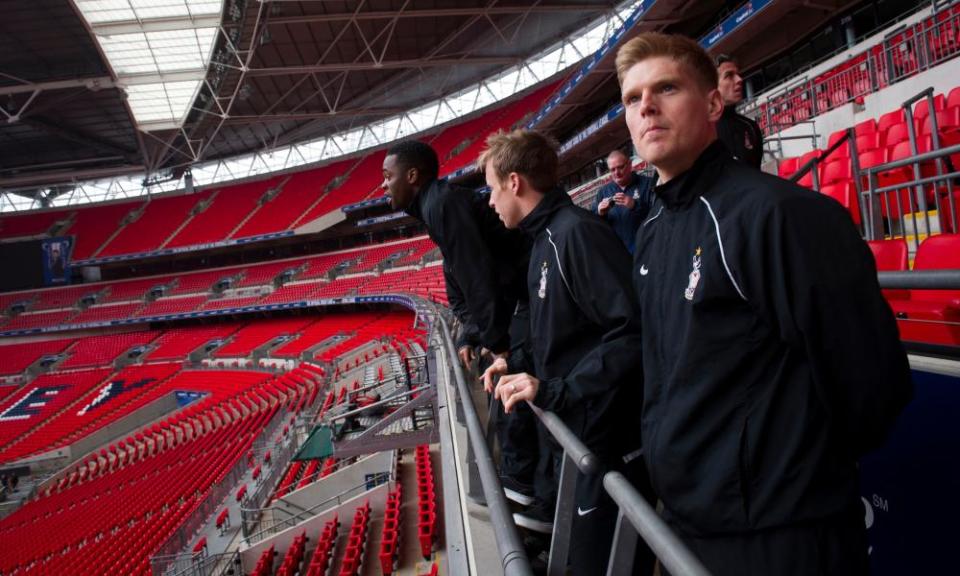‘Safe’ standing barriers are anything but, says former Wembley Stadium manager

The introduction of safe standing areas could create new safety problems in football grounds, according to Noel Jeffs, an expert in stadium operations and a former general manager of Wembley Stadium.
This month the Sports Ground Safety Authority (SGSA) confirmed that six clubs will trial safe standing areas in the Premier League and Championship from the new year. The decision follows lengthy campaigning by fan groups and years observing behaviour at a select number of grounds across the UK and Europe.
However, Jeffs has called the new rules into question, in particular over a decision to set safety standards lower than those required by regular building standards. Under building regulations, crush barriers must be a minimum height of 1.1m to prevent people falling over them, but under the guidance for safe standing trials established by the SGSA, they can go as low as 80cm, even though some of the SGSA’s own documentation states that this may not be high enough.
Download the Guardian app from the iOS App Store on iPhones or the Google Play store on Android phones by searching for 'The Guardian'.
If you already have the Guardian app, make sure you’re on the most recent version.
In the Guardian app, tap the yellow button at the bottom right, then go to Settings (the gear icon), then Notifications.
Turn on sport notifications.
“What the SGSA has done is reduce the height of the barriers, which is not a risk-based solution but a performance-based one,” says Jeffs. “How have we gone from high barriers being unsafe to low barriers being safe?”
Jeffs cites the fall of a spectator during England’s Euro 2020 fixture against Croatia at Wembley (which has no safe standing) as an example of something that could go wrong. “The fan at Wembley fell from the upper tier over an 80cm barrier,” Jeffs said. “Low barriers just don’t work. The steeper the terracing the more likelihood that you will fall forward, particularly when you’re jumping up and down through excitement or you can’t see or you’ve been pushed out of the way. That’s where a lot of the risks are.”

Jeffs also argues that the nature of most rail seating, which allows seating areas to be used as standing sections when desired, is potentially dangerous because each row is lined up directly behind the next. This means fans have their sightlines restricted and makes them more likely to move along rows and cause further risks of falling or creating blockages on exits and gangways. “It’s a fact that if you go and stand one behind another in normal terracing you cannot see the near side touchline, so your view is obstructed,” he said. “They’ll be standing one behind each other and won’t be able to see.”
Related: Premier League and Championship clubs to trial safe standing from January
The SGSA has defended its choice of barrier heights and the type of seating installed as part of safe standing trials. It says the regulations will be an improvement on the current situation, where fans are ignoring the rules to stand in seated areas.
The head of inspectorate at the SGSA, Ken Scott, who wrote the guidance for licensed standing, argued that rather than new risks being created, “a key and major risk will be averted as soon as these rails go in”, adding: “The risk of what we call progressive crowd collapse [where one fan falling would cause another to fall and so on] is stopped because of the intervening barrier on every single row of seats and it’s for that reason that we’re comfortable with the barrier height.”
Under the guidance, clubs will be expected to convey to fans – perhaps via a code of conduct – that they should stay in their place, even if they cannot see the play. “A lot of fans have been requesting this change for a number of years now, so we’re reflecting a social norm,” Scott said. “We’re giving people choice on the basis that they will be watched, they will be monitored and that they will need to treat the latitudes they’ve been given with respect. If fans don’t behave, the local authorities have the ability to reduce capacities. I’m confident that fans will treat this really well.”
Jeffs is more sceptical. “Can a person fall over a low height barrier, for example during goal celebrations, on to the person standing in the row in front, causing them to fall forwards or sideways? The answer is yes,” he says. “Fans will be standing one behind each other and won’t be able to see, but it’s their responsibility to stay where they are. Of course they’re not going to do that, because [stewards] can’t make them sit now. It’s never going to work.”
Jeffs has created a form of rail seat, the 2020 stadium seat, compliant with the more stringent regulations set out in the SGSA’s central rulebook, the Green Guide, which is being trialled at Wycombe in League One. “The important thing for me was that if you put the existing recommendations from the Green Guide in there, anyone can make a seat,” he says. “It’s the perception that’s been created around this. You call something safe and people think it’s safe. But it’s not safe and that’s wrong.”

 Yahoo Sport
Yahoo Sport 





































